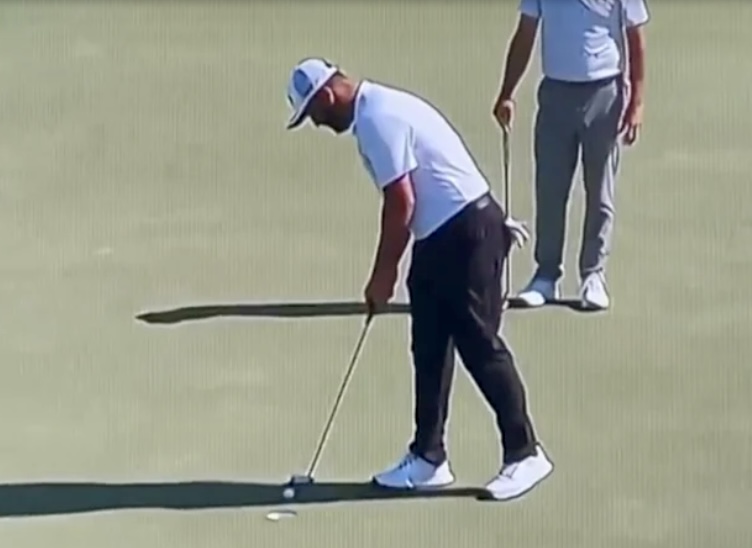It’s been said in countless ways how the game of golf is a metaphor for life. Yet there’s always room for another. Yesterday the #1 ranked player in the world, Jon Rahm, gave us two more.
Playing in the Arnold Palmer Invitational just outside of Orlando, Florida, Rahm had a 10-inch putt for par on the 7th hole. A 10-inch putt is so short that most beginner golfers will knock it in with little concern — much less a 15 handicap — much less a five — much less a scratch — much less a mini-tour player. But on the PGA Tour?
On Thursday it happened to the best player on earth. And Rahm didn’t even come close. He didn’t just miss it on either side of the hole; he barely brushed the ball. It labored forward a mere four inches.

I’ve been watching golf on TV ever since I started playing 40 years ago. This miss was about the most puzzling one I’ve ever seen in a professional round. Even the announcers were baffled as to what to say.
Yet the Spaniard barely flinched. He bogeyed the hole and stood at two over par as he quietly moved on to the eighth tee. Then he played his last 11 holes in two under par — right on track with his ordinary (extraordinary) scoring average.
After the round, Rahm knew he’d get the question. And he answered it just as calmly as he had moved on after the original gaffe:
“It’s as simple as, you know, it just didn’t feel good in my hands, and I tried to stop, and I didn’t. I just simply didn’t stop. I don’t know. It was very odd…It sucks to give away a shot like that, to be honest.”
No excuses. No bullshit. A humble explanation and honesty about his frustration. On to the next round.
To be clear — and serious golf fans will know this — the 27-year-old Rahm has not always been this way. Far from it. He was known as a hothead in his early years and got plenty of hazing over it. In 2018 he turned the corner some on his attitude, and then after a setback at the PGA Championship last year, he made a concentrated effort to settle himself. A month later, he kept his cool through the ups and downs of an exhilarating final round at the U.S. Open — and won his first major in dramatic fashion. Afterwards, Phil Mickelson noted:
“When he stayed really calm and level-headed through a challenging stretch, that’s the result. You can see the difference. You can see where it was a couple years ago and where it is now. It’s inspiring and impressive.”
The second thing that grabbed me as I watched the evening replay of Thursday’s round was a surprising factoid that the announcers passed on about Rahm’s sand wedge. But before I pass it on here, a little breakdown for the uninitiated.
Most PGA players get their clubs customized by some of the best technicians in the golf world. This makes perfect sense, as competition at the highest level of the game really boils down to physical precision and what’s in your head. And a lot of that precision is in your head. They drive each other. Confidence. Security.
Here is a video of Rahm hitting a bunch of green-side chips with his 60-degree sand wedge at the Ely Callaway Performance Center. Roger Cleveland, a master wedge specialist, is on hand working with Rahm.

Just to give you an idea of how esoterically precise players like Rahm get with their equipment, here’s how GOLF writer Jonathan Wall described what Cleveland does to perfect Rahm’s wedge:
“Rahm is surgical around the greens, but even the best wedge players in the world can use a bit of leading edge relief, especially on squared-up shots. Removing material from the sole allows the leading edge to impact the turf efficiently without digging. In other words, it keeps Rahm from chunking it on tight lies.”
Simple, right? Sure.
So back to the announcers. NBC’s Dan Hicks and Justin Leonard were talking about Rahm’s custom Callaway wedge and showing an image of it while he was playing the fifth hole. Then Leonard added this detail:
“Something interesting I found out this morning. He changes his 60-degree wedge and puts a new one in play pretty much every week on Tour. He doesn’t want the grooves to dull out. He wants as much grip between the ball and the clubface as possible.”
Jimmy Roberts followed Leonard: “I’ve never heard that before from a player.”
Um, me neither, Jimmy. I barely keep my grooves clean on the 60-degree I’ve been playing for two years — and it’s one of the best clubs in my bag!
Rahm’s method reminded me of the story about Tiger Woods telling a club-maker in 1999 that the weight of the custom “Cameron” putter he’d made for him was a few grams too heavy. There are 454 grams in a pound. The club-maker drilled out two thin dots in the front and back of the putter and painted them with Tiger’s signature red. Then Tiger won eight of his last 12 tournaments in ‘99 and nine more the following year. And the putter stayed in his bag for more than a decade.
Rahm’s weekly wedge-refresh model also reminded me of Michael Jordan’s practice of wearing a new pair of Nikes for every game. At home. On the road. Didn’t matter. Eighty-two games per regular NBA season he wanted that same feeling of stepping onto the court in pristinely untouched high-tops.
The people who become truly excellent at the things that are important to them almost always have a lot more going on than natural skill or smarts. Character and the qualities that flow from it usually drive everything else. As George C. Scott’s “Bert Gordon” said to Paul Newman’s “Fast Eddie” in The Hustler:
“Everybody’s got talent. I got talent. You think you can play big-money straight pool or poker for 40 straight hours on nothing but talent? You think they call Minnesota Fats the best in the country just ‘cause he’s got talent?”
Rahm made a mistake on that 10-inch putt. Everybody makes mistakes. Every day. It’s the ways in which we bounce back from them — or from disappointments or unforeseen challenges — that truly define us. Watching others, I’m frequently reminded of how the qualities of composure, positivity and focusing-on-the-now usually win the day.
Jon Rahm is currently the best player in the world. Being the best at anything — or even truly exceptional at it — never comes easily. Yet we do get opportunities to vastly increase the odds of our success by making a commitment to practicing and learning everything we possibly can that has the power to make us better.
Shakespeare once wrote: “All the world’s a stage.” So is a golf course. Any golf round you watch someone play is like an instant MRI of their M.O. And very often, drawing life lessons from what we’re observing can be as easy as holing a 10-inch putt.
Okay, maybe a four-incher.


